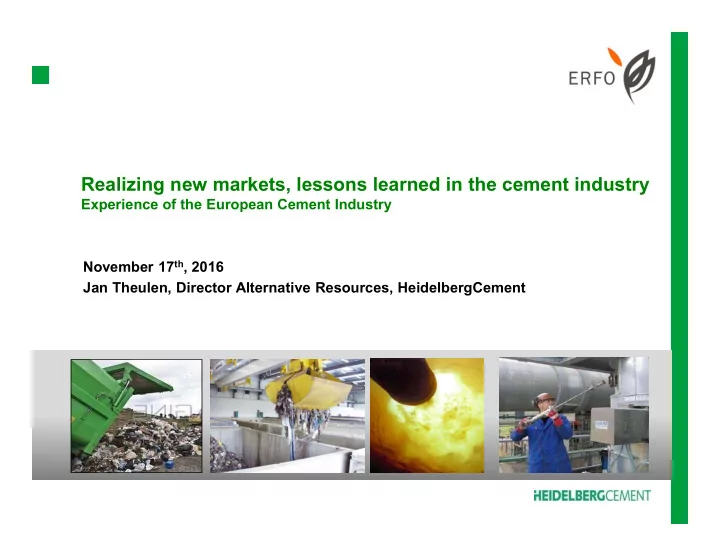

Realizing new markets, lessons learned in the cement industry Experience of the European Cement Industry November 17 th , 2016 Jan Theulen, Director Alternative Resources, HeidelbergCement
Contents 1. Actual role of cement industry in Circular Economy 2. Lessons learned – Poland – Romania – Italy 3. Outlook
How does cement industry fit into the circular economy?
Quantity of WtE versus WtC in European countries Waste to Energy in Europe (kg/cap) Waste to Cement in Europe Waste to Energy and Waste to Cement co-exist in Europe
Municipal Waste options – ecological comparison methane to energy environment efficiency 100% no Normal landfill 35% 40% Landfill gas to power >35% 0% Waste to Electricity ash disposal (incineration) >70% 0% Waste to Cement no ash disposal Slide 5 - 2014 Global Environmental Sustainability
Municipal Waste options - continued Capital + Land operational costs occupation 100% 100% Normal landfill 95% 110% Landfill gas to power 30% ‘>150% Waste to Electricity ash disposal (incineration) 25% 100% Waste to Cement mineral disposal Slide 6 - 2014 Global Environmental Sustainability
Co-processing of RDF/SRF in cement kiln environmental friendly Long residence time at Complete destruction organics, high temperature no PCDD/DF formation Combustion rich in oxygen Neutralisation of acid gases, and active lime SOx and hydrogen chloride High clinker mass stream Heavy metals stable embedded Ashes of fuel in clinker Zero waste solution replacing raw material
Contents 1. Actual role of cement industry in Circular Economy 2. Lessons learned – Poland – Romania – Italy 3. Outlook
Best practice example: Poland Source: USE OF ECONOMIC INSTRUMENTS AND WASTE MANAGEMENT PERFORMANCES Final Report, 10 April 2012, Contract ENV.G.4/FRA/2008/0112 • Cement Industry in Poland already in 2004 replaced 10% of coal by SRF/RDF • Landfill diversion only 2% and very low landfilling costs • Imports from Germany were the driving force for the early development Cross border flows SRF @ are essential for market development !
Best practice example: Poland – Future • Poland 2012: 8 mio ton to landfill • Capacity: cement plants 1,5 mio tons + 6 incinerators 2015: 1,2 mio tons • 2016 ban on landfill of MSW > 6 GJ/t Classification SRF important for export out of Poland!
Best practice Romania, EU-country with low landfill tax landfill > 80% landfill fee: <10 €/t Slide 11 AFR Core Group
Opportunity Romania: low costs MBT Unlike Czech, Poland or Hungary, import of RDF into Romania very difficult Primary fuel prices Romania are high Tipping fee for landfill of MSW only around 5 €/t Low cost biodrying technology applied AF-rate 2013 Lafarge Romania 44% Slide 12 Global Environmental Sustainability Jan Theulen
Low cost biodrying plant for MSW treatment Dry waste (after 25 days): 17 % moisture > 14 GJ/ton Manual covering Aeration of the waste Turning the waste
Best practice Italy, EU-country with high landfill tax landfill > 45% landfill fee: >120 €/t Slide 14 AFR Core Group
Italy: not a single country is so suspicious to use waste Waste is traditionally a sector in Italy where government is not in full control Permits are to be established locally to all stakeholders are important for success Example of resistance to RDF: Convegno su Css a Senise - Shortcut.lnk Extensive education of officials and public required February 2015 Global Fuels Dubai Slide15
Final remarks To achieve full potention of SRF in cement industry we need to act case by case: – Eliminate public and (local) regulator resistance against MBT and SRF co-processing – Bring landfill tax upward for some countries – Work on low cost technologies, adapted to GDP- level of a country to accelarate SRF development We do need to keep exchanging our problems and success stories Even with low coal prices use of SRF by cement industry is feasible, as investment in burning and gascleaning already exist Slide 16 Global Environmental Sustainability Jan Theulen
Waste is a resource…. Contacts: Jan Theulen Director Alternative Resources Global Environmental Sustainability jan.theulen@ heidelbergcement.com +31 62 9097 354
Recommend
More recommend